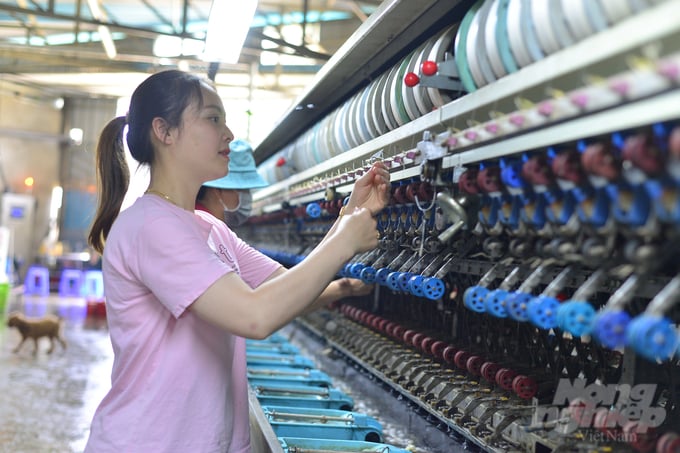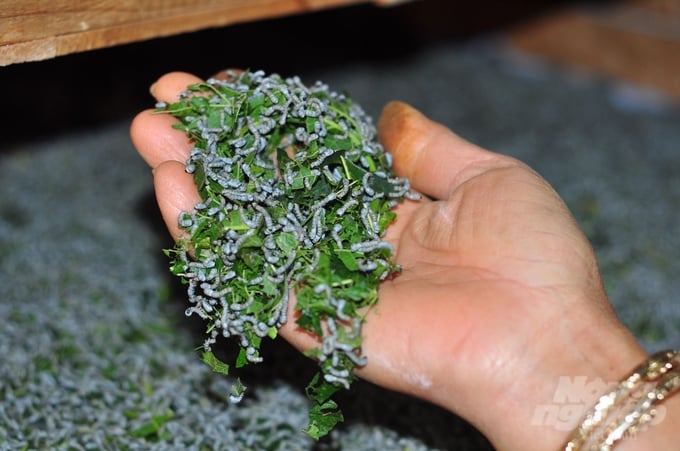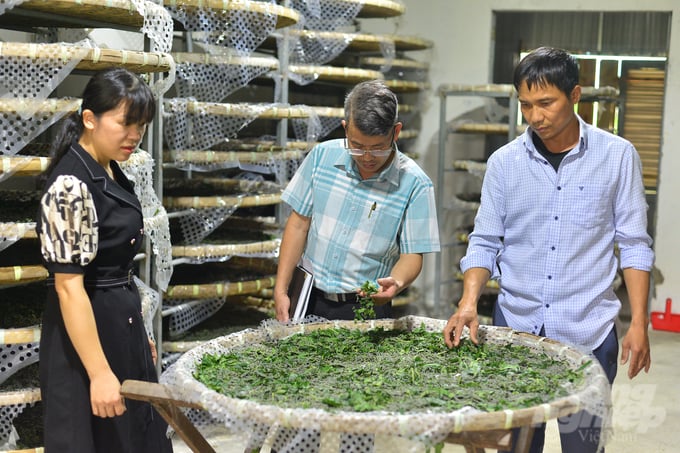June 21, 2025 | 03:14 GMT +7
June 21, 2025 | 03:14 GMT +7
Hotline: 0913.378.918
June 21, 2025 | 03:14 GMT +7
Hotline: 0913.378.918
The Ministry of Agriculture and Rural Development, in collaboration with the Lam Dong Provincial People's Committee, organized a conference on the sustainable development of Vietnam's silkworm industry on December 2.
During the conference, Mr. Tong Xuan Chinh, Deputy Director of the Department of Livestock Production, emphasized that sericulture, a traditional profession in Vietnam, is currently experiencing rapid development, ranking fifth globally after China, India, Uzbekistan, and Thailand.

Mr. Phung Duc Tien, Deputy Minister of Agriculture and Rural Development, stated that the sericulture industry hasexperienced robust growth with an export turnover of 100 million USD. Photo: Minh Hau.
According to Mr. Chinh, there are currently 32 provinces nationwide engaged in mulberry production for silkworms, covering an area of over 13 thousand hectares. Both the acreage and cocoon yield have consistently increased within the last few years. Notably, Vietnam produced nearly 12 thousand tons of various types of cocoons in 2019, marking an increase of 43% compared to 2018. Subsequently, this figure has reached nearly 17 thousand tons by 2022.
"The sericulture industry currently accounts for approximately 2% of Vietnam's total agricultural export turnover," stated Mr. Tong Xuan Chinh.
According to the Department of Livestock Production, the majority of the sericulture industry is located in the Central Highlands, accounting for 77% of the country's total mulberry production area. The sericulture industry in other regions, including the Red River Delta, Northern Midlands and Mountainous region, North Central and South Central Coast, account for proportions ranging from 3 to 11%.
With the current prices of yellow cocoons ranging from 110,000 to 120,000 Vietnamese dong per kilogram and prices of white cocoons ranging from 170,000 to 205,000 Vietnamese dong per kilogram, silkworm farmers enjoy a high level of incomes, at two to three times higher compared to that of other crops such as rice, tea, and sugarcane.
Mr. Tong Xuan Chinh reported that Vietnam currently features two main silkworm varieties: mulberry silkworm and eri silkworm. The mulberry silkworm is predominantly farmed nationwide and consists of the dual-breed yellow cocoon variety and the dual-breed white cocoon variety. The eri silkworm is raised in several midland and mountainous regions.
Presently, Vietnamese sources of dual-breed white silkworm eggs can only meet 10% of the national demand, with 90% of these eggs imported from China.
According to the Department of Livestock Production, the use of dual-breed white silkworm seeds is crucial in the production process. However, their imports are primarily conducted through small-scale channels. Consequently, unofficia imports lead to extended processing times and insufficient quality control, thereby posing a high risk to farmers.
"We still rely on importing silkworm varieties to serve production, and this is a very important issue that must be addressed," Mr. Tong Xuan Chinh stressed.

Mulberry production for silkworms accounts for approximately 2% of Vietnam's total agricultural export turnover. Photo: Minh Hau.
Subsequently, Mr. Chinh believes that it is necessary to plan the macro-level development of the sericulture industry and invest in human resources, infrastructure, and establish a standard system for silkberry products. Additionally, emphasis must be placed on researching and breeding new, high-yield generations of mulberry and silkworm varieties.
According to Dr. Le Quang Tu, Chairman of the Vietnam Silk Association, Vietnam's sericulture industry currently utilizes a set of high-yield mulberry varieties with a productivity of 45 tons per hectare, and has successfully developed a silkworm cocoon seed. However, the industry suffers from lack of a development strategy and direction, the inability to proactively secure dual-breed white silkworm eggs, and overreliance on seed imports from China. These challenges have led to the unsustainable development of the sericulture industry.
"The organization of production and consumption within the sericulture industry is predominantly spontaneous, accompanied by the lack of an established production linkage for processing and consumption. The establishment of sericulture cooperatives and complexes face numerous challenges. Central investment funds for the sericulture industry are limited, relying on socialization. Additionally, the infrastructure is underdeveloped and lacks coherence," Dr. Le Quang Tu explained.

The sericulture industry experienced robust growth with an export turnover of 100 million USD. However, production is reliant on silkworm seed sources from China. Photo: Minh Hau.
Dr. Tu proposed: "It is necessary to focus on building a strategic development plan for Vietnam's sericulture industry. On the other hand, we must negotiate with China at the national level to import silkworm eggs through official channels, and gradually introduce two domestic silk varieties, VH2020 and LD-09, for production."
At the conference, Mr. Nguyen Van Chau, Deputy Director of the Lam Dong province's Department of Agriculture and Rural Development, stated that the province currently has 10 thousand hectares of mulberry production area, with a cocoon yield of 16 thousand tons and a silk yield of over 2 thousand tons per year.
"The province needs to import 350,000 - 400,000 boxes of dual-breed silkworm eggs every year to serve production. All of these eggs are imported from China through unofficial channels, without quarantine, and their quality is unreliable," reported Mr. Nguyen Van Chau. Additionally, he recommended the Ministry of Agriculture and Rural Development to guide specialized agencies in supporting businesses with the official import of silkworm eggs to ensure quality for production.
Furthermore, the Ministry must direct relevant agencies to strengthen research efforts and production of silkworm eggs, thereby eliminating reliance on foreign sources.
Ms. Nguyen Thi Phuong Lan, Director of Minh Quang Lam Co., Ltd. in Bao Loc city, Lam Dong province, shared that in addition to negotiating with China for the official import of silkworm eggs, it is necessary to build cold storage facilities with the aim of preserving and actively managing the egg source. Additionally, she recommended stakeholders to attract domestic and foreign investments in the production of silkworm egg and the construction of a large-scale demonstration model for silkworm breeding with domestic dual-breed eggs.
At the conference, Mr. Phung Duc Tien, Deputy Minister of Agriculture and Rural Development, emphasized that the sericulture industry is a high-value sector with an export turnover of at least 100 million USD. Notably, this sector experienced significant fluctuations in the past, and it is currently experiencing stable positive developments.

There are currently 38,000 households engaged in silkworm production nationwide, and the growth rate is increasing rapidly over the years. Photo: Minh Hau.
According to Deputy Minister Phung Duc Tien, there are currently 38,000 households engaged in silkworm production nationwide, and the growth rate is increasing rapidly over the years. Incomes from the sericulture industry fall between 300 and 400 million Vietnamese dong per hectare. Multiple Vietnamese silk products have entered the global market. The sericulture industry is currently experiencing strong growth, with high-yield mulberry varieties and potential silkworm varieties.
Deputy Minister Tien believes that the sericulture industry is significantly restricted by the pressing issue of seed. Additionally, the processing industry and collaboration between parties are severely limited. As a result, Deputy Minister Tien suggested stakeholders to prioritize building a strategic development plan for the sericulture industry. Additionally, there is a need for research and development of seed, and the implementation of scientific programs on seed.
Deputy Minister Phung Duc Tien also recommended stakeholders to strengthen their efforts in managing scientific and technological activities. Research institutions must reinforce their research capacities, and products must meet quality and cost factors. On the other hand, agencies need to collaborate to establish production linkages, and organize trade promotion events to expand the market.
Regarding the agricultural extension system, Deputy Minister Tien proposed enhancing communication, and organizing training and workshops at the grassroots level, in combination with coordinating with businesses to expand the scale of production with new technical advancements in the sericulture industry.
According to Mr. Nguyen Ngoc Phuc, Vice Chairman of Lam Dong Provincial People's Committee, the province is currently regarded as the "capital" of silk in the country. Accordingly, Lam Dong possesses favorable conditions for the development of the sericulture industry. However, current production relies on small-scale imported silkworm seeds from China. Additionally, local production linkages face numerous limitations.
Translated by Nguyen Hai Long
![Turning wind and rain into action: [9] Digitizing hydrometeorological data in response to climate change](https://t.ex-cdn.com/nongnghiepmoitruong.vn/608w/files/news/2025/06/17/z6704423696987_15fd32ffc26d590d204d520c9dac6786-nongnghiep-165943.jpg)
(VAN) Farmers have begun accessing hydrometeorological applications to adjust their cropping schedules, aiming to ensure productivity and adapt to climate change.
![Turning wind and rain into action: [8] Real-time salinity detection and early warning technology](https://t.ex-cdn.com/nongnghiepmoitruong.vn/608w/files/news/2025/06/17/z6704423696987_15fd32ffc26d590d204d520c9dac6786-nongnghiep-151127.jpg)
(VAN) Thanks to the integration of modern hydrological-hydraulic models, remote sensing technologies, and artificial intelligence, the accuracy of hydrological forecasting has significantly improved.
![Turning wind and rain into action: [7] Early disaster warnings help marine farmers minimize losses](https://t.ex-cdn.com/nongnghiepmoitruong.vn/608w/files/news/2025/06/17/z6704423696987_15fd32ffc26d590d204d520c9dac6786-nongnghiep-142942.jpg)
(VAN) In recent years, thanks to early disaster warnings and forecasting, marine farmers in Khanh Hoa province have been able to reduce risks and losses, thereby improving production efficiency.
![Turning wind and rain into action: [6] ‘Four on-the-spot’ disaster management software](https://t.ex-cdn.com/nongnghiepmoitruong.vn/608w/files/news/2025/06/17/e5a48259d6a262fc3bb3-nongnghiep-183800.jpg)
(VAN) By simply activating the scenario on the disaster management software, the relevant authorities immediately know how many households need to be evacuated, where to evacuate them to, and by what means of transportation…
![Turning wind and rain into action: [5] Hue applies modern technology in disaster forecasting](https://t.ex-cdn.com/nongnghiepmoitruong.vn/608w/files/news/2025/06/17/z6704423696987_15fd32ffc26d590d204d520c9dac6786-nongnghiep-093938.jpg)
(VAN) In Hue city, modern technology has recently been applied in meteorological and hydrological forecasting and warning, helping to reduce the damage caused by natural disasters.

(VAN) A cutting-edge farming technique being implemented on an experimental ranch in Arizona's Sonoran Desert has already saved a billion gallons of water over five years, according to Civil Eats.

(VAN) Poultry and pig production and the environment can be boosted through enhanced water technology, according to new research.